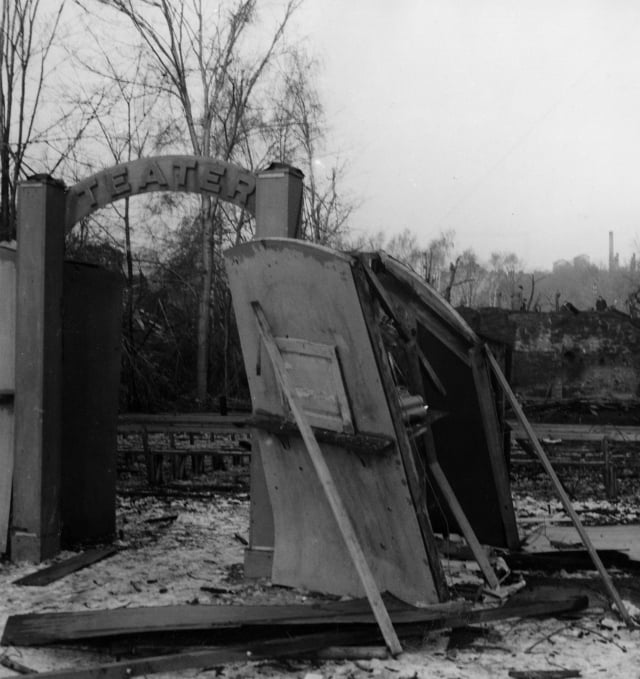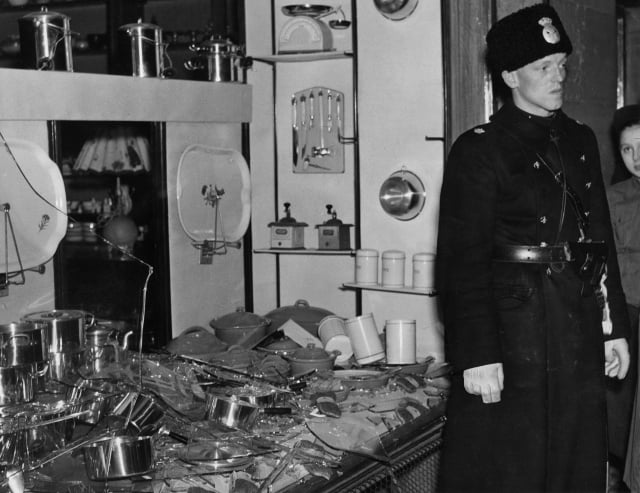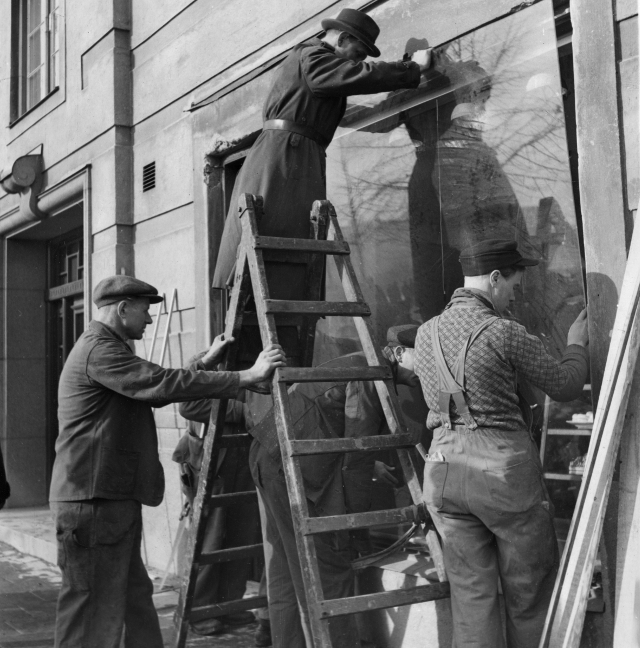The day Stockholm was bombed by the Soviet Union

Seventy-five years ago, Sweden's questionable wartime neutrality, a Russian spy, and three "missing" Soviet bombers led to devastation in Stockholm.
This article is available to Members of The Local. Read more Membership Exclusives here.
On the morning of February 23rd, 1944, daylight revealed the devastation of the aerial bombardment that had taken place overnight. Shocked city residents gathered to see and assess the damage, including the near-total destruction of the new open-air theatre, where a large crater had been left behind by a 100-kilogram bomb.
With World War Two raging, it wasn't an uncommon sight, and images like these would seem almost ordinary for the time were it not for the fact that this was not a strategic Axis or Allied target city like London, Hamburg, or Nantes, but rather Stockholm in neutral Sweden.

An outdoor theatre at Eriksdal in Stockholm was damaged in the bombings. Photo: Svenska Dagbladet/TT
Exactly why the bombs were dropped on parts of Stockholm and Strängnäs is still debated, and though the evidence – including bomb fragments found with Cyrillic lettering – points to Russia as the culprit, that country has never wavered from its position that the only bombings that took place that night were of the Finnish cities of Helsinki, Turku and Kotka. Likewise, Sweden has always maintained its stance that the bombing was an "accident" caused by an error of navigation on the part of the Soviets. But apart from these disparate official positions, there are at least two theories about the Soviet bombing of Stockholm and Strängnäs.
As it had during the entirety of World War Two, Sweden had officially taken a position of "non-belligerence" during the brief Winter War between Finland and the Soviet Union in 1940, and during the Continuation War, which lasted from 1941 to September 1944, in which Finland allied with Nazi Germany against Russia. In reality, Sweden had unofficially sided with Finland in the two lesser conflicts. Swedish volunteers fought alongside the Finns against the Soviets, and the early 1940s was a period rife with spy activity between Russia and Sweden.

A police officer in a store on the Götgatan street in Stockholm. Photo: Svenska Dagbladet/TT
One theory of the bombing is that it was a deliberate Soviet warning to Sweden not to provide further support to Finland, unofficial or otherwise. The other is that the bombing was conducted by the Soviets in order to force Sweden to release and pardon one of its spies, Vasilij Aleksandrovitj Sidorenko, who had been arrested in Stockholm in 1942, convicted of espionage against Sweden, and imprisoned at Långholmen island in Stockholm.
Specifically, one of Sidorenko's espionage targets had been the Södermanland Regiment in Strängnäs, an armoured division of the Swedish army. As it happened, this was precisely the location of some of the early bombs "accidentally" dropped between shortly after 8pm on February 22nd and nearly 1am the next morning. Fortunately, as in the other areas that were bombed, no one was killed, though two soldiers were injured by shrapnel.
Around the same time the bombs were falling on Strängnäs, another aircraft was bombing the Eriksdal area in Södermalm, central Stockholm. The area suffered extensive damage, though only relatively minor injuries were reported. One of the most badly-damaged areas was Eriksdalslunden park, where the open-air theatre featured in this image was located, and an abandoned water plant was also hit. One of the buildings damaged was a pump house which was salvaged and later moved to Hammarbyslussen, where it is still stands and is known as Ryska Smällen (Russian Bang).
Before it was all over, several more bombs were dropped on other areas of Stockholm, mostly in the northern archipelago. In the end, the airplanes that conducted the bombings supposedly disappeared, something that both Swedish and Russian officials seemed to agree on.

Workers mending windows that were shattered in the blast. Photo: Svenska Dagbladet/TT
In a 2014 article written for the Swedish Aviation Historical Society (Svensk Flyghistorisk Förening), Sven-Åke Björk cites a telegram written on February 24th, 1944, by Sir Victor Mallet, Great Britain's envoy to Sweden, and sent to the British Foreign Office in London, in which Mallet wrote: "Secretary General told me today that there was practically no doubt that the bombs were Russian and accidentally dropped. The Russians had reported four aircraft missing after Åbo... [Turku] raid of which one was known to have been shot down and presumably the other three were those which visited the Stockholm area and had afterwards probably crashed in the sea."
Whether it was a warning or an accident, the bombing appears to have made a political impact. Sweden never escalated its support of Finland, and on February 25th, as Stockholm was slowly getting back to normal, the Russian spy Sidorenko was officially pardoned by the Swedish government. He left Sweden for Scotland two days later.
Victoria Martínez is an American historical researcher, writer and author of three historical non-fiction books. She lives in Småland county, Sweden, with her Spanish husband and their two children.
Comments (1)
See Also
This article is available to Members of The Local. Read more Membership Exclusives here.
On the morning of February 23rd, 1944, daylight revealed the devastation of the aerial bombardment that had taken place overnight. Shocked city residents gathered to see and assess the damage, including the near-total destruction of the new open-air theatre, where a large crater had been left behind by a 100-kilogram bomb.
With World War Two raging, it wasn't an uncommon sight, and images like these would seem almost ordinary for the time were it not for the fact that this was not a strategic Axis or Allied target city like London, Hamburg, or Nantes, but rather Stockholm in neutral Sweden.

An outdoor theatre at Eriksdal in Stockholm was damaged in the bombings. Photo: Svenska Dagbladet/TT
Exactly why the bombs were dropped on parts of Stockholm and Strängnäs is still debated, and though the evidence – including bomb fragments found with Cyrillic lettering – points to Russia as the culprit, that country has never wavered from its position that the only bombings that took place that night were of the Finnish cities of Helsinki, Turku and Kotka. Likewise, Sweden has always maintained its stance that the bombing was an "accident" caused by an error of navigation on the part of the Soviets. But apart from these disparate official positions, there are at least two theories about the Soviet bombing of Stockholm and Strängnäs.
As it had during the entirety of World War Two, Sweden had officially taken a position of "non-belligerence" during the brief Winter War between Finland and the Soviet Union in 1940, and during the Continuation War, which lasted from 1941 to September 1944, in which Finland allied with Nazi Germany against Russia. In reality, Sweden had unofficially sided with Finland in the two lesser conflicts. Swedish volunteers fought alongside the Finns against the Soviets, and the early 1940s was a period rife with spy activity between Russia and Sweden.

A police officer in a store on the Götgatan street in Stockholm. Photo: Svenska Dagbladet/TT
One theory of the bombing is that it was a deliberate Soviet warning to Sweden not to provide further support to Finland, unofficial or otherwise. The other is that the bombing was conducted by the Soviets in order to force Sweden to release and pardon one of its spies, Vasilij Aleksandrovitj Sidorenko, who had been arrested in Stockholm in 1942, convicted of espionage against Sweden, and imprisoned at Långholmen island in Stockholm.
Specifically, one of Sidorenko's espionage targets had been the Södermanland Regiment in Strängnäs, an armoured division of the Swedish army. As it happened, this was precisely the location of some of the early bombs "accidentally" dropped between shortly after 8pm on February 22nd and nearly 1am the next morning. Fortunately, as in the other areas that were bombed, no one was killed, though two soldiers were injured by shrapnel.
Around the same time the bombs were falling on Strängnäs, another aircraft was bombing the Eriksdal area in Södermalm, central Stockholm. The area suffered extensive damage, though only relatively minor injuries were reported. One of the most badly-damaged areas was Eriksdalslunden park, where the open-air theatre featured in this image was located, and an abandoned water plant was also hit. One of the buildings damaged was a pump house which was salvaged and later moved to Hammarbyslussen, where it is still stands and is known as Ryska Smällen (Russian Bang).
Before it was all over, several more bombs were dropped on other areas of Stockholm, mostly in the northern archipelago. In the end, the airplanes that conducted the bombings supposedly disappeared, something that both Swedish and Russian officials seemed to agree on.

Workers mending windows that were shattered in the blast. Photo: Svenska Dagbladet/TT
In a 2014 article written for the Swedish Aviation Historical Society (Svensk Flyghistorisk Förening), Sven-Åke Björk cites a telegram written on February 24th, 1944, by Sir Victor Mallet, Great Britain's envoy to Sweden, and sent to the British Foreign Office in London, in which Mallet wrote: "Secretary General told me today that there was practically no doubt that the bombs were Russian and accidentally dropped. The Russians had reported four aircraft missing after Åbo... [Turku] raid of which one was known to have been shot down and presumably the other three were those which visited the Stockholm area and had afterwards probably crashed in the sea."
Whether it was a warning or an accident, the bombing appears to have made a political impact. Sweden never escalated its support of Finland, and on February 25th, as Stockholm was slowly getting back to normal, the Russian spy Sidorenko was officially pardoned by the Swedish government. He left Sweden for Scotland two days later.
Victoria Martínez is an American historical researcher, writer and author of three historical non-fiction books. She lives in Småland county, Sweden, with her Spanish husband and their two children.
Join the conversation in our comments section below. Share your own views and experience and if you have a question or suggestion for our journalists then email us at [email protected].
Please keep comments civil, constructive and on topic – and make sure to read our terms of use before getting involved.
Please log in here to leave a comment.